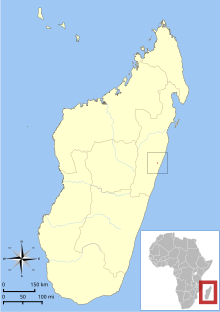Gerp's mouse lemur
| Gerp's mouse lemur | |
|---|---|

| |
| Scientific classification | |
| Domain: | Eukaryota |
| Kingdom: | Animalia |
| Phylum: | Chordata |
| Class: | Mammalia |
| Order: | Primates |
| Suborder: | Strepsirrhini |
| Family: | Cheirogaleidae |
| Genus: | Microcebus |
| Species: | M. gerpi
|
| Binomial name | |
| Microcebus gerpi Radespiel et al., 2012[3]
| |

| |
| Distribution of M. gerpi[1] | |
Gerp's mouse lemur (Microcebus gerpi) is a species of
Based on genetic studies, measurements, and photos, the research team confirmed the Gerp's mouse lemur was an undescribed species, distinct from Goodman's mouse lemur, which is found 58-kilometre (36 mi) away. Gerp's mouse lemur is significantly larger, weighing on average 68-gram (2.4 oz), compared to Goodman's mouse lemur, which weighs about 44 g (1.6 oz). Jolly's mouse lemur, which is its closest relative and a neighbor to the south, is comparably larger, but differs in tail length and genetics.
Because it is a recently discovered species, little is known about its behavior, communication, ecology, or reproduction. The species appears to be restricted to a small region of lowland evergreen rain forest, and is seriously threatened by forest loss.
Evolutionary and taxonomic history

Gerp's mouse lemur was discovered by German and Malagasy members of the Malagasy organization Groupe d'Étude et de Recherche sur les Primates de Madagascar (GERP) in a previously unstudied lowland forest known as the Sahafina Forest in eastern
The discovery was published in the journal Primates in 2012. The species was named after the research and conservation team that described it. Gerp's mouse lemur differed genetically and physically from all of its nearest neighboring mouse lemur species. Its tail is longer than its closest relative, Jolly's mouse lemur (M. jollyae), which lives further south and whose tail is 18% shorter. It also has a higher body mass (68 g (2.4 oz)) and is generally larger than Goodman's mouse lemur (M. lehilahytsara), which weighs about 44 g (1.6 oz). Gerp's mouse lemur exhibits significant genetic differences from its northern neighbor, Simmons' mouse lemur (M. simmonsi).[3]
The genetics tests initially conducted focused on three different
Anatomy and physiology
Among mouse lemurs, Gerp's mouse lemur is larger-bodied and has a long tail, which can be used to store fat. The fur is darker on its back, which is brownish-gray with a broad reddish line down the middle, compared to the front, which varies from a light gray to creamy white and extends from the throat to the genitals. The outer arms and legs contrast the rest of the body with their darker color, and the fingers have sparse, whitish-gray fur. The head is reddish in color, with darker brown surrounding the eyes and a noticeable white stripe across the nose and between the eyes. Its ears are prominent, yet small, with dark brown edges. The tail is covered in dense, long, brownish-gray fur. The
Gerp's mouse lemur weighs around 68 g (2.4 oz) and has a tail length of approximately 146.5 mm (5.77 in). It is a large-bodied mouse lemur, and belongs to a group of large mouse lemurs (weighing more than 50 grams (1.8 oz)), including four eastern species—Simmons' mouse lemur, Jolly's mouse lemur, the
Behavior
No data are available concerning the behavior, communication, ecology, or reproduction of the Gerp's mouse lemur, although such data may help support its species status.[3]
Distribution and habitat
Gerp's mouse lemur has only been identified in the Sahafina Forest in eastern Madagascar, about 58 km (36 mi) east of Mantadia National Park, 87 km (54 mi) south of the city of Toamasina, and 18 km (11 mi) from the Indian Ocean. The forest fragment is about 15.6 km2 (6.0 sq mi) and is surrounded by secondary forest growing in areas previously cut for rice cultivation (known locally as savoka).[3]
The Sahafina Forest ranges from 29 to 230 m (95 to 755 ft) above sea level, whereas nearby Mantadia National Park, home of its closest neighboring mouse lemur population (Goodman's mouse lemur), ranges from 900 to 1,200 m (3,000 to 3,900 ft) above sea level. No major rivers separate these highland and lowland forests and their respective mouse lemur populations. The initial study did not conclude whether the large Rianila River or one of the smaller rivers—the Ivonoro and Onibe—further north acts as a species boundary between Gerp's mouse lemur and Simmons' mouse lemur (M. simmonsi) to the north. Approximately 160 km (99 mi) the south lies the Mangoro River, a very large river that acts as a biogeographic barrier for many species. In 2010, a genetically distinct form of mouse lemur was sequenced from Marolambo, 25 km (16 mi) south of the river. The geographic range of Gerp's mouse lemur is unlikely to extend south of this river, but more studies are needed to confirm this. In total, the area between the rivers to the north and south, the highlands to the west, and the ocean to the east is no larger than 7,600 km2 (2,900 sq mi) (smaller than the island of Puerto Rico) and this is the likely extent of its geographic range.[3]
Conservation status
There are no protected areas within the known geographic range of Gerp's mouse lemur. Because it lives in lowland forests, which are more likely to be converted into agricultural land relative to highland rainforests, it faces an elevated conservation risk. Of the 7,600 km2 (2,900 sq mi) of its potential geographic range, only very small parts remain forested.[3]
References
- ^ . Retrieved 19 November 2021.
- ^ "Checklist of CITES Species". CITES. UNEP-WCMC. Retrieved 18 March 2015.
- ^ S2CID 8473176.

